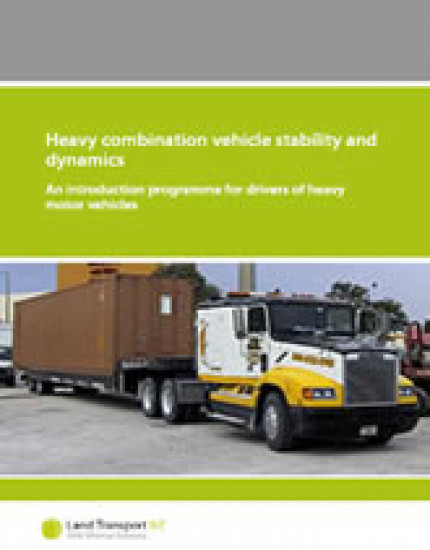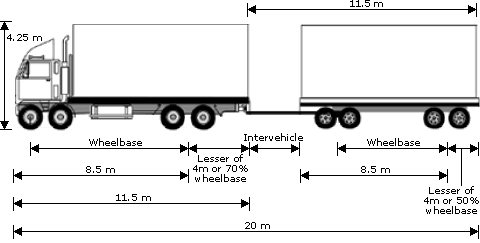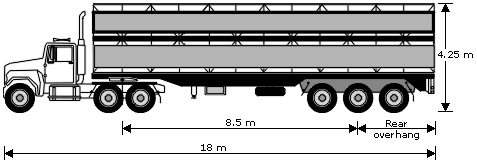An introduction programme for drivers of heavy motor vehicles

There are two common types of combination vehicle in use on New Zealand roads: truck and trailer; and semi-trailer including ‘B’ trains. A third type common some years ago was the ‘A’ train, but many of these had an inherent stability problem, which has resulted in them being progressively withdrawn from service.
The images below show typical examples of common types of heavy vehicle combinations that can be found in New Zealand, together with their relevant maximum dimensions.
Truck and trailer unit

Semi-trailer

‘B’ train (two semi-trailers)

‘A’ train (one semi-trailer with a full trailer behind)

On a stability rating chart, and taking all relevant factors into consideration, the above combination vehicles can be rated against each other as follows:
| Stability | Rating | Combination |
|---|---|---|
| Most stable | 1 | Prime mover and semi-trailer |
| 2 | ‘B’ train | |
| 3 | Truck and full trailer | |
| Least stable | 4 | ‘A’ train |
Notwithstanding the above, each type of combination has some inherent characteristics that drivers need to be aware of when they are operating a vehicle of the particular type.
| Vehicle type | Inherent characteristics |
|---|---|
| ‘A’ train | Driver generally receives no roll over feedback. |
| Susceptible to trailer yaw. | |
| Rear trailer can roll over completely independent of semi-trailer. | |
| Because of the large number of pivot points, this type of combination is susceptible to rearward amplification. | |
| Can be difficult to reverse. | |
| Prime mover and semi-trailer | Due to the manner in which the trailer is coupled to the prime mover, in the event of a roll over the complete combination will roll. |
| Not susceptible to yaw except in extreme situations. | |
| Very susceptible to the effects of low-speed off-tracking. | |
| Relatively easy to reverse. | |
| ‘B’ train | Due to the manner in which the trailer is coupled to the prime mover, in the event of a roll over the complete combination will roll. |
| Not susceptible to yaw except in extreme situations. | |
| Very susceptible to the effects of low speed off-tracking particularly when manoeuvring. | |
| Relatively easy to reverse. | |
| Has a large turning circle. | |
| Rigid truck and full trailer | Driver generally receives no roll over feedback. |
| Susceptible to trailer yaw. | |
| Rear trailer can roll over completely independent of towing vehicle. | |
| Good turning circle. | |
| Can be difficult to reverse. | |
| Loading must be spilt between towing vehicle and trailer to ensure adequate braking and traction. |